Agricultural Practice in Poland Before and After Mandatory IPM Implementation by the European Union
Abstract
:1. Introduction
- Prevention and/or suppression of harmful organism supported by non-chemical options like crop rotation, adequate cultivation techniques, use of resistant/tolerant cultivars, use of balanced fertilization, hygiene measures, protection and enhancement of beneficial organisms;
- Harmful organism must be monitored;
- Protection measures must be based on monitoring;
- Biological, physical, and other non-chemical methods must be preferred to chemical method;
- Pesticides should be specific and have minimum side effects;
- Levels of applied intervention should be kept to a necessary minimum;
- Anti-resistant strategy should be performed;
- The success of plant protection measures should be implemented [13].
- crop rotation with appropriate sowing dates
- agricultural technology, including mechanical operations
- adoption of pest resistant plant varieties
- application of fertilization, irrigation and liming
- cleaning and disinfection of machinery and objects that could contribute to the spread of harmful organisms
- promotion of preservation and improvement of the conditions for the development of beneficial organisms, such as pollinating insects and pests’ natural enemies
- date of intervention
- the name of the plant being grown,
- field area (ha),
- the size of the surface on which the treatment was performed,
- field number,
- trade name of the measure,
- name of the active substance,
- dose per 1 ha
- the reason for using the agent, including the disease,
- weather conditions during the procedure,
- development phase l. treatment effectiveness.
2. Materials and Methods
2.1. Study Sites
2.2. Survey Methodology
3. Results
4. Discussion
Author Contributions
Funding
Acknowledgments
Conflicts of Interest
References
- E Ehler, L. Integrated pest management (IPM): Definition, historical development and implementation, and the other IPM. Pest Manag. Sci. 2006, 62, 787–789. [Google Scholar] [CrossRef]
- Erbaugh, M.; Kibwika, P.; Donnermeyer, J. Assessing Extension Agent Knowledge and Training Needs to Improve IPM Dissemination in Uganda. J. Int. Agric. Ext. Educ. 2007, 14, 14. [Google Scholar] [CrossRef] [Green Version]
- Ziska, L.H.; Bradley, B.A.; Wallace, R.D.; Bargeron, C.T.; Laforest, J.H.; Choudhury, R.A.; Garrett, K.A.; Vega, F.E. Climate Change, Carbon Dioxide, and Pest Biology, Managing the Future: Coffee as a Case Study. Agronomy 2018, 8, 152. [Google Scholar] [CrossRef] [Green Version]
- Sawinska, Z.; Strzelinska, J.; Switek, S.; Glowicka-Woloszyn, R. Integrated pest management (IPM) still not sufficiently used in practice. Phytopathology 2018, 108. Available online: https://apsjournals.apsnet.org/doi/pdf/10.1094/PHYTO-108-10-S1.240 (accessed on 3 February 2020).
- Thresher, R.E.; Hayes, K.; Bax, N.J.; Teem, J.; Benfey, T.J.; Gould, F. Genetic control of invasive fish: Technological options and its role in integrated pest management. Biol. Invasions 2014, 16, 1201–1216. [Google Scholar] [CrossRef]
- Parsa, S.; Morse, S.; Bonifacio, A.; Chancellor, T.C.B.; Condori, B.; Crespo-Pérez, V.; Hobbs, S.L.A.; Kroschel, J.; Ba, M.N.; Rebaudo, F.; et al. Obstacles to integrated pest management adoption in developing countries. Proc. Natl. Acad. Sci. USA 2014, 111, 3889–3894. [Google Scholar] [CrossRef] [PubMed] [Green Version]
- Zalucki, M.P.; Adamson, D.; Furlong, M.J. The future of IPM: Whither or wither? Aust. J. Èntomol. 2009, 48, 85–96. [Google Scholar] [CrossRef]
- Meissle, M.; Mouron, P.; Musa, T.; Bigler, F.; Pons, X.; Vasileiadis, V.P.; Otto, S.; Antichi, D.; Kiss, J.; Pálinkás, Z.; et al. Pests, pesticide use and alternative options in European maize production: Current status and future prospects. J. Appl. Èntomol. 2009, 134, 357–375. [Google Scholar] [CrossRef]
- Świtek, S.; Sawinska, Z. Farmer rationality and the adoption of greening practices in Poland. Sci. Agricola 2017, 74, 275–284. [Google Scholar] [CrossRef]
- Ruiu, L. Microbial Biopesticides in Agroecosystems. Agronomy 2018, 8, 235. [Google Scholar] [CrossRef] [Green Version]
- Directive 2009/128/EC of the European Parliament and of the Council of 21 October 2009 Establishing a Framework for Community Action to Achieve the Sustainable use of Pesticides. Available online: https://eur-lex.europa.eu/LexUriServ/LexUriServ.do?uri=OJ:L:2009:309:0071:0086:en:PDF (accessed on 3 February 2020).
- C/2017/8878 Commission Implementing Regulation (EU) 2017/2470 of 20 December 2017 Establishing the Union List of Novel Foods in Accordance with Regulation (EU) 2015/2283 of the European Parliament and of the Council on Novel Foods. Available online: https://eur-lex.europa.eu/legal-content/EN/TXT/?uri=CELEX%3A32017R2470 (accessed on 3 February 2020).
- European Commission Sustainable Use Pesticide. Available online: https://ec.europa.eu/food/plant/pesticides/sustainable_use_pesticides/ipm_en (accessed on 20 December 2019).
- Rozporządzenie Ministra Rolnictwa i Rozwoju Wsi z dnia 18 kwietnia 2013 r. w sprawie wymagań integrowanej ochrony roślin. Available online: http://prawo.sejm.gov.pl/isap.nsf/DocDetails.xsp?id=WDU20130000505 (accessed on 3 February 2020).
- Rozporządzenie Ministra Rolnictwa i Rozwoju Wsi z dnia 8 maja 2013 r. w sprawie szkoleń z zakresu środków ochrony roślin. Available online: http://prawo.sejm.gov.pl/isap.nsf/DocDetails.xsp?id=WDU20130000554 (accessed on 3 February 2020).
- Wymagania dla stosujących środki ochrony roślin. Available online: http://piorin.gov.pl/srodki-ochrony-roslin/wym-dla-stosujacych-sor (accessed on 29 January 2020).
- Obwieszczenie ministra rolnictwa i rozwoju wsi z dnia 6 maja 2013 r. w sprawie krajowego planu działania na rzecz ograniczenia ryzyka związanego ze stosowaniem środków ochrony roślin. Available online: http://prawo.sejm.gov.pl/isap.nsf/DocDetails.xsp?id=WMP20130000536 (accessed on 3 February 2020).
- Świadczenie usług doradczych w ramach PROGRAMU ROZWOJU OBSZARÓW WIEJSKICH 2014–2020. Available online: https://www.cdr.gov.pl/informacje-branzowe/uslugi-doradcze-prow-2014-2020 (accessed on 3 February 2020).
- Bryła, M.; Waśkiewicz, A.; Podolska, G.; Szymczyk, K.; Jędrzejczak, R.; Damaziak, K.; Sułek, A. Occurrence of 26 Mycotoxins in the Grain of Cereals Cultivated in Poland. Toxins 2016, 8, 160. [Google Scholar] [CrossRef] [PubMed] [Green Version]
- Kanianska, R. Agriculture and Its Impact on Land-Use, Environment, and Ecosystem Services. In Landscape Ecology—The Influences of Land Use and Anthropogenic Impacts of Landscape Creation; IntechOpen: London, UK, 2016. [Google Scholar]
- Birch, A.N.E.; Begg, G.S.; Squire, G.R. How agro-ecological research helps to address food security issues under new IPM and pesticide reduction policies for global crop production systems. J. Exp. Bot. 2011, 62, 3251–3261. [Google Scholar] [CrossRef] [PubMed] [Green Version]
- Lamichhane, J.R.; Dachbrodt-Saaydeh, S.; Kudsk, P.; Messéan, A. Towards a reduced reliance on conventional pesticides in European agriculture. Plant Dis. 2016, 100, 10–24. [Google Scholar] [CrossRef] [PubMed] [Green Version]
- Barzman, M.; Bàrberi, P.; Birch, A.N.E.; Boonekamp, P.; Dachbrodt-Saaydeh, S.; Graf, B.; Hommel, B.; Jensen, J.E.; Kiss, J.; Kudsk, P.; et al. Eight principles of integrated pest management. Agron. Sustain. Dev. 2015, 35, 1199–1215. [Google Scholar] [CrossRef]
- Sadighi, H.; Roosta, K. Assessing farmers’ sustainable agricultural practice needs: The case of corn growers in fars, Iran. J. Agric. Sci. Technol. 2002, 4, 103–110. [Google Scholar]
- Walczak, F. Agrophages monitoring in agricultural integrated plant protection. Fragm. Agron. 2010, 27, 147–154. [Google Scholar]
- Nowak, M.M. Resource Base of the Dairy Industry in a Regional Frame. Rocz. Nauk. Stowarzyszenia Ekon. Rol. i Agrobiznesu 2016, 18, 189–194. [Google Scholar]
- Poczta, W.; Bartkowiak, N. Regional Differentiation of Agriculture in Poland. J. Agribus. Rural Dev. 2012, 1, 95–109. [Google Scholar]
- Produkcja upraw rolnych i ogrodniczych w 2016 roku. Available online: https://stat.gov.pl/obszary-tematyczne/rolnictwo-lesnictwo/uprawy-rolne-i-ogrodnicze/produkcja-upraw-rolnych-i-ogrodniczych-w-2016-roku,9,15.html (accessed on 27 January 2020).
- The Characteristics of Agricultural Holdings in Wielkopolskie Voivodship. Available online: https://poznan.stat.gov.pl/ (accessed on 29 January 2020).
- Menardo, F.; Praz, C.R.; Wicker, T.; Keller, B. Rapid turnover of effectors in grass powdery mildew (Blumeria graminis). BMC Evol. Boil. 2017, 17, 223. [Google Scholar] [CrossRef] [Green Version]
- Tomkowiak, A.; Skowrońska, R.; Buda, A.; Kurasiak-Popowska, D.; Nawracała, J.; Kowalczewski, P.Ł.; Pluta, M.; Radzikowska, D. Identification of Leaf Rust Resistance Genes in Selected Wheat Cultivars and Development of Multiplex PCR. Open Life Sci. 2019, 14, 327–334. [Google Scholar]
- Tomkowiak, A.; Skowrońska, R.; Weigt, D.; Kwiatek, M.; Nawracała, J.; Kowalczewski, P.Ł.; Pluta, M. Identification of Powdery Mildew Blumeria graminis f. sp. tritici Resistance Genes in Selected Wheat Varieties and Development of Multiplex PCR. Open Chem. 2019, 17, 157–165. [Google Scholar] [CrossRef]
- David, S.; Asamoah, C. Farmer knowledge as an early indicator of IPM adoption: A case study from cocoa farmer field schools in Ghana. J. Sustain. Dev. Afr. 2011, 13, 213–224. [Google Scholar]
- Golinowska, M.; Kruszyński, M.; Bogacz, M. Costs of integrated plant protection in large-scale farms in 2006–2012. Prog. Plant Prot. 2013, 53, 240–246. [Google Scholar]
- Shennan, C. Profiles of California farmers by degree of IPM use as indicated by self-descriptions in a phone survey. Agric. Ecosyst. Environ. 2001, 84, 267–275. [Google Scholar] [CrossRef]
- Kruszyński, M.; Golinowska, M.; Borkowska, M.; Wiciak, T. Pro-environmental awareness of agricultural producers and integrated pest management in Poland. Prog. Plant Prot. 2015, 55, 114–118. [Google Scholar] [CrossRef] [Green Version]
- Liu, X.; Lehtonen, H.; Purola, T.; Pavlova, Y.; Rötter, R.; Palosuo, T. Dynamic economic modelling of crop rotations with farm management practices under future pest pressure. Agric. Syst. 2016, 144, 65–76. [Google Scholar] [CrossRef]
- Kurowski, T.P.; Marks, M.; Makowski, P.; Jaźwińska, E. Health status of winter wheat depending on the two years method of lying the land fallow. Fragm. Agron. 2009, 26, 102–108. [Google Scholar]
- El Khoury, W.; Makkouk, K. Integrated Plant Disease Management in Developing Countries. J. Plant Pathol. 2010, 92, 35–42. [Google Scholar] [CrossRef]
- Matyjaszczyk, E. Plant protection in Poland on the eve of obligatory integrated pest management implementation. Pest Manag. Sci. 2013, 69, 991–995. [Google Scholar] [CrossRef]
- Nave, S.; Jacquet, F.; Jeuffroy, M.-H. Why wheat farmers could reduce chemical inputs: Evidence from social, economic, and agronomic analysis. Agron. Sustain. Dev. 2013, 33, 795–807. [Google Scholar] [CrossRef]
- Fernandez-Cornejo, J.; Beach, E.D.; Huang, W.-Y. The Adoption of IPM Techniques By Vegetable Growers in Florida, Michigan and Texas. J. Agric. Appl. Econ. 1994, 26, 158–172. [Google Scholar] [CrossRef] [Green Version]
- Blake, G.; Sandler, H.; Coli, W.; Pober, D.; Coggins, C. An assessment of grower perceptions and factors influencing adoption of IPM in commercial cranberry production. Renew. Agric. Food Syst. 2007, 22, 134–144. [Google Scholar] [CrossRef]
- Kilpatrick, S.; Johns, S. How farmers learn: Different approaches to change. J. Agric. Educ. Ext. 2003, 9, 151–164. [Google Scholar] [CrossRef]
- Samiee, A.; Rezvanfar, A.; Faham, E. Factors influencing the adoption of integrated pest management (IPM) by wheat growers in Varamin County, Iran. Afr. J. Agric. Res. 2009, 4, 491–497. [Google Scholar]
- Lichtenberg, E.; Zimmerman, R. Information and farmers’ attitudes about pesticides, water quality, and related environmental effects. Agric. Ecosyst. Environ. 1999, 73, 227–236. [Google Scholar] [CrossRef]
- Calliera, M.; Berta, F.; Galassi, T.; Mazzini, F.; Rossi, R.; Bassi, R.; Meriggi, P.; Bernard, A.; Marchis, A.; Di Guardo, A.; et al. Enhance knowledge on sustainable use of plant protection products within the framework of the Sustainable Use Directive. Pest Manag. Sci. 2013, 69, 883–888. [Google Scholar] [CrossRef]
- Ilbery, B.; Maye, D.; Little, R. Plant disease risk and grower–agronomist perceptions and relationships: An analysis of the UK potato and wheat sectors. Appl. Geogr. 2012, 34, 306–315. [Google Scholar] [CrossRef]
- Palis, F.G. The role of culture in farmer learning and technology adoption: A case study of farmer field schools among rice farmers in central Luzon, Philippines. Agric. Hum. Values 2006, 23, 491–500. [Google Scholar] [CrossRef]
- Pouratashi, M.; Iravani, H. Farmers’ knowledge of integrated pest management and learning style preferences: Implications for information delivery. Int. J. Pest Manag. 2012, 58, 347–353. [Google Scholar] [CrossRef]
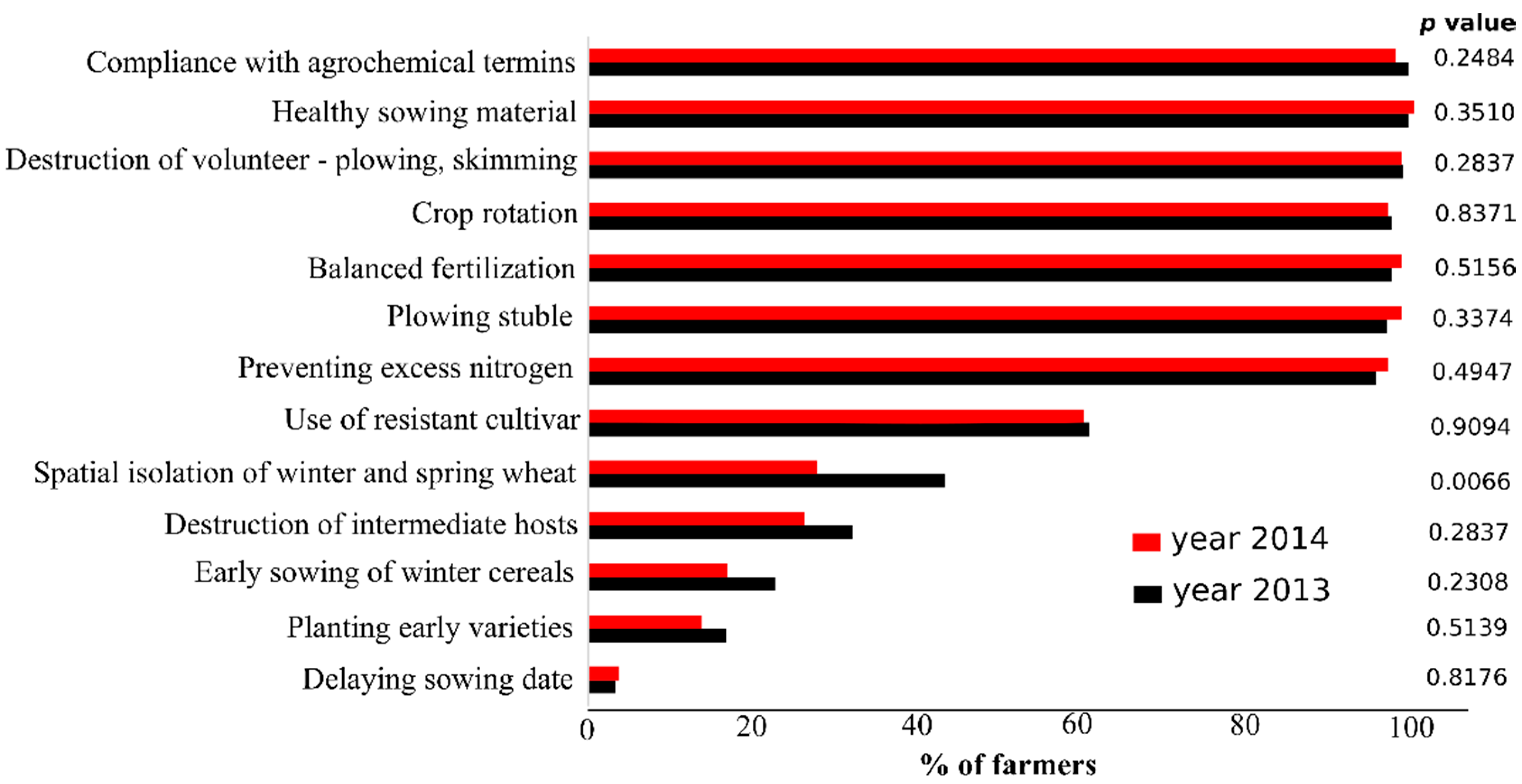
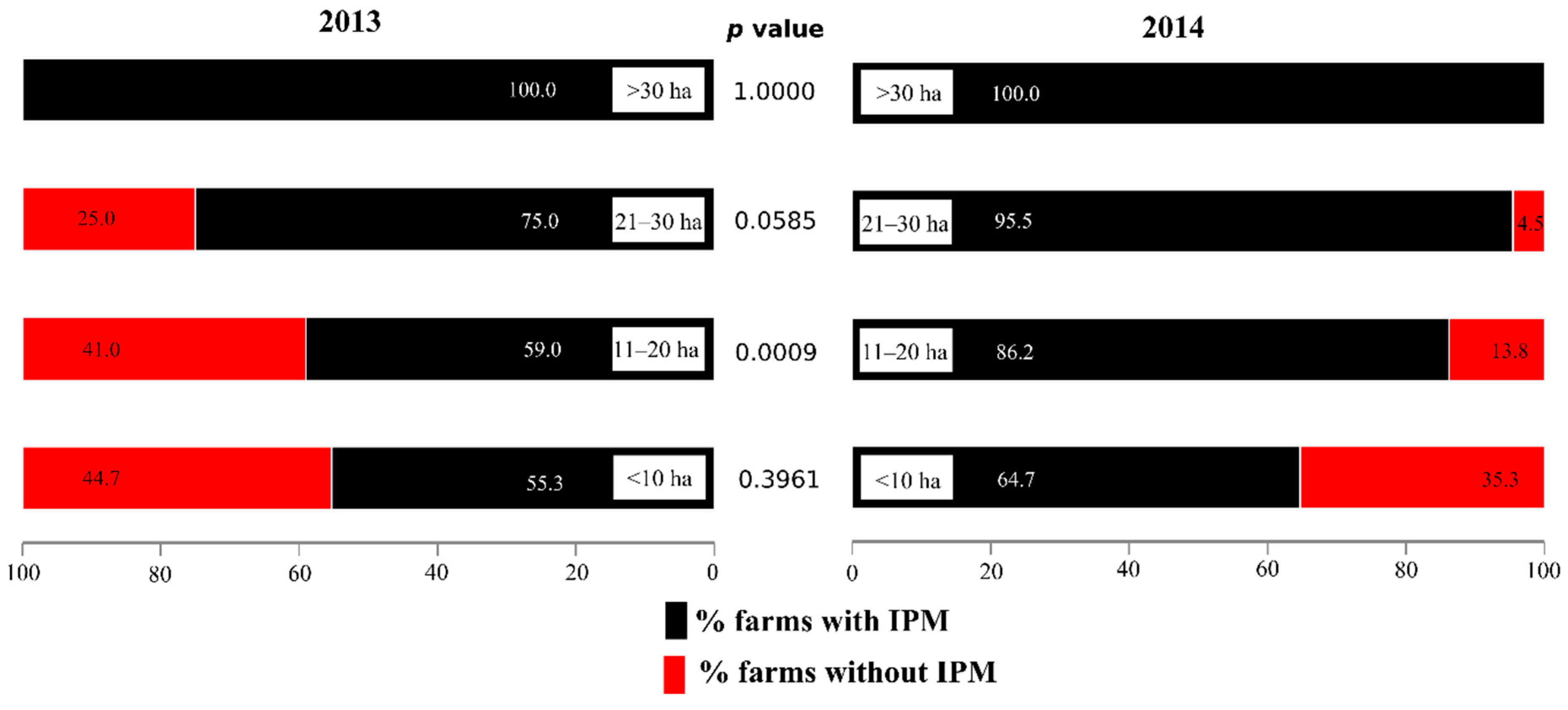
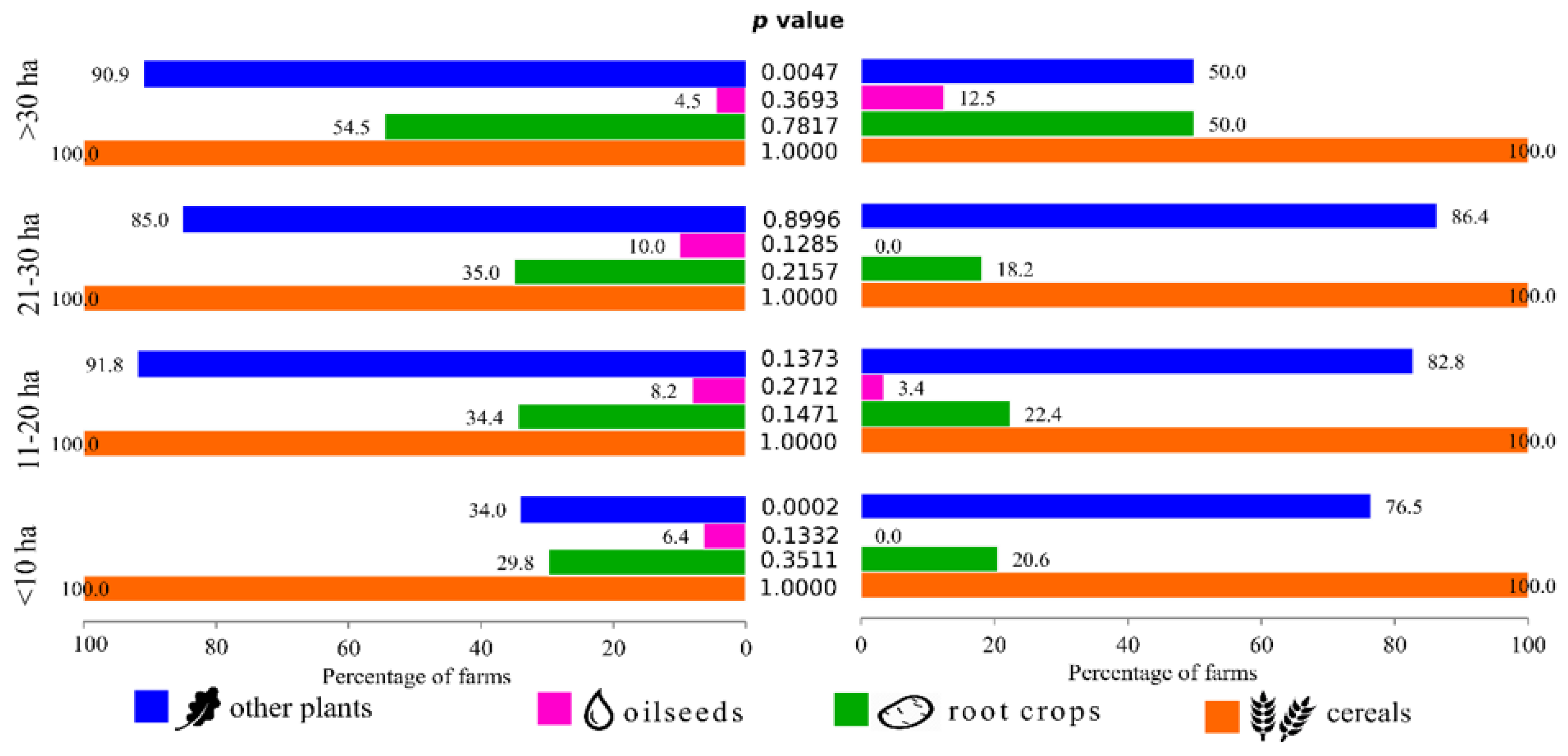
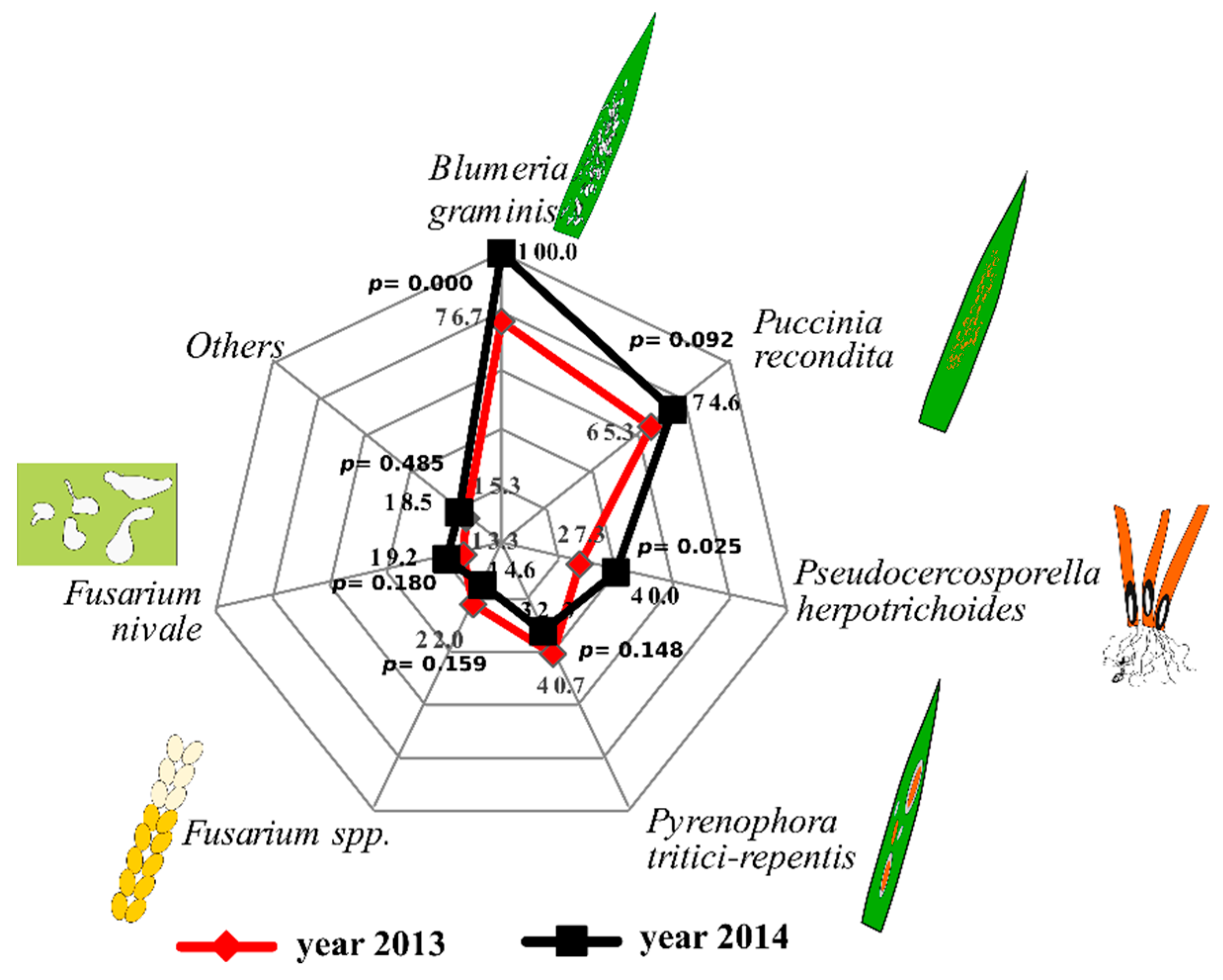
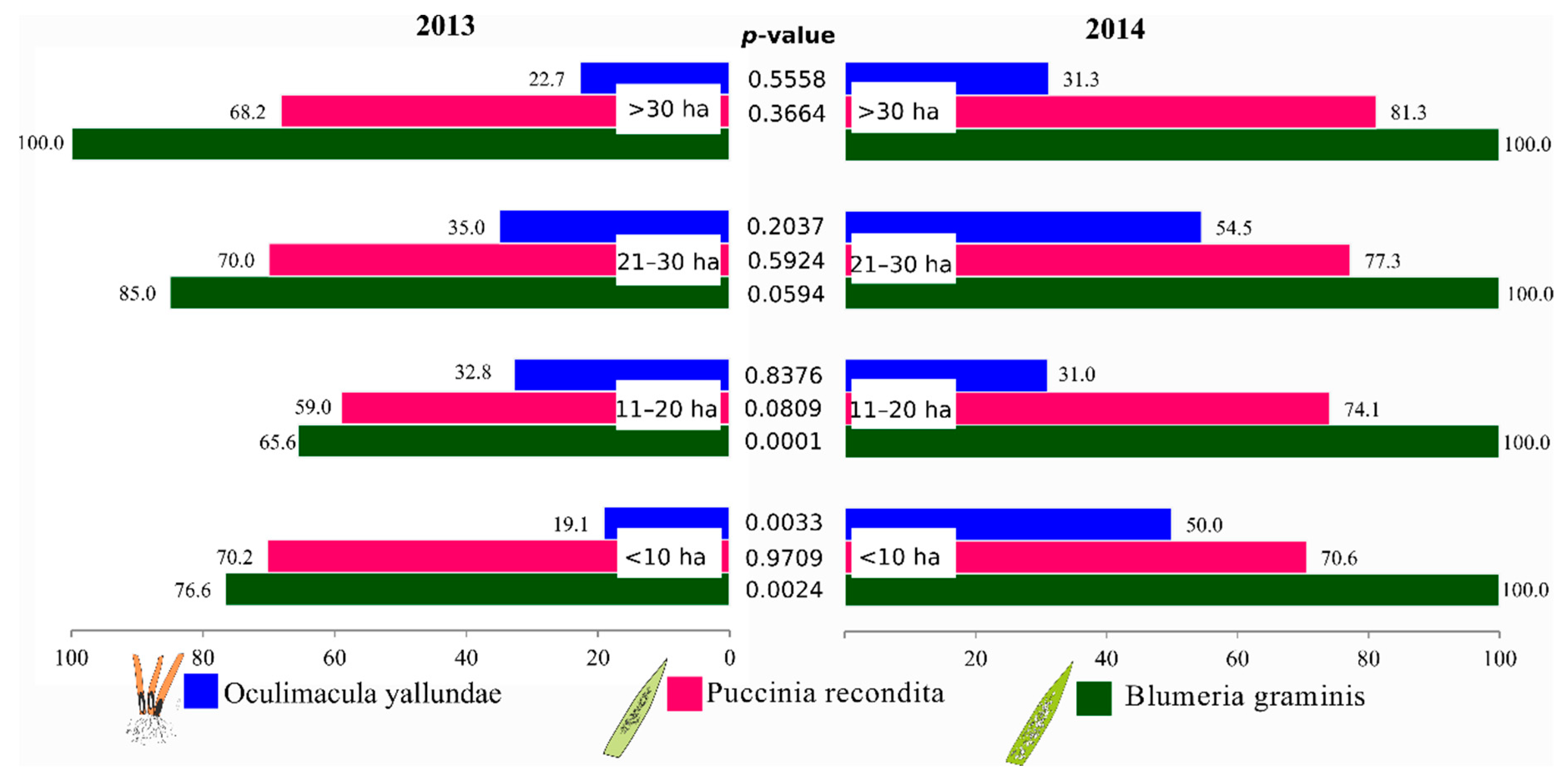
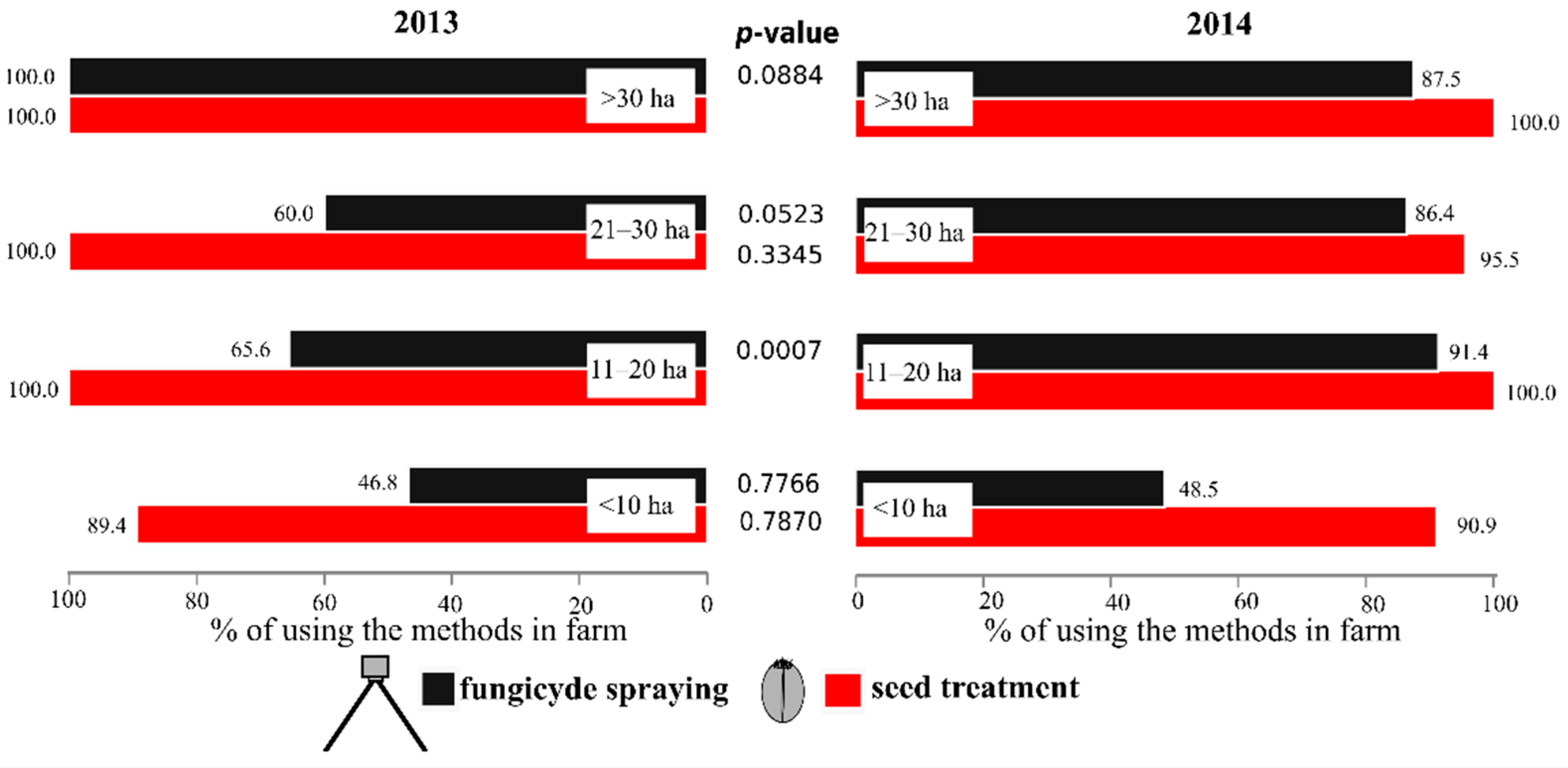

| Farms Area | Number of Questionnaires 2013 | Number of Questionnaires 2014 |
|---|---|---|
| <10 ha | 47 | 34 |
| 11–20 ha | 61 | 58 |
| 21–30 ha | 20 | 22 |
| >30 ha | 22 | 16 |
© 2020 by the authors. Licensee MDPI, Basel, Switzerland. This article is an open access article distributed under the terms and conditions of the Creative Commons Attribution (CC BY) license (http://creativecommons.org/licenses/by/4.0/).
Share and Cite
Sawinska, Z.; Świtek, S.; Głowicka-Wołoszyn, R.; Kowalczewski, P.Ł. Agricultural Practice in Poland Before and After Mandatory IPM Implementation by the European Union. Sustainability 2020, 12, 1107. https://doi.org/10.3390/su12031107
Sawinska Z, Świtek S, Głowicka-Wołoszyn R, Kowalczewski PŁ. Agricultural Practice in Poland Before and After Mandatory IPM Implementation by the European Union. Sustainability. 2020; 12(3):1107. https://doi.org/10.3390/su12031107
Chicago/Turabian StyleSawinska, Zuzanna, Stanisław Świtek, Romana Głowicka-Wołoszyn, and Przemysław Łukasz Kowalczewski. 2020. "Agricultural Practice in Poland Before and After Mandatory IPM Implementation by the European Union" Sustainability 12, no. 3: 1107. https://doi.org/10.3390/su12031107
APA StyleSawinska, Z., Świtek, S., Głowicka-Wołoszyn, R., & Kowalczewski, P. Ł. (2020). Agricultural Practice in Poland Before and After Mandatory IPM Implementation by the European Union. Sustainability, 12(3), 1107. https://doi.org/10.3390/su12031107








